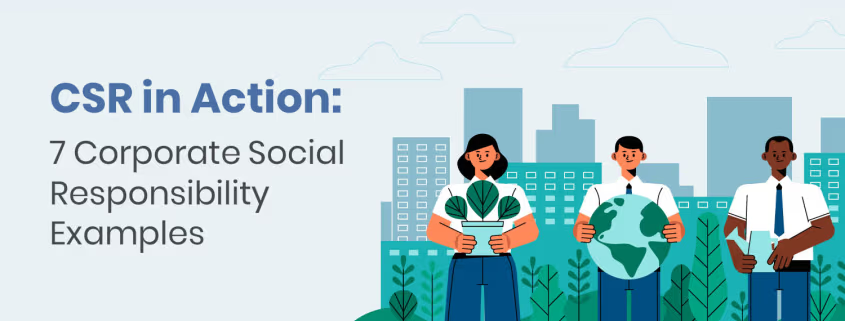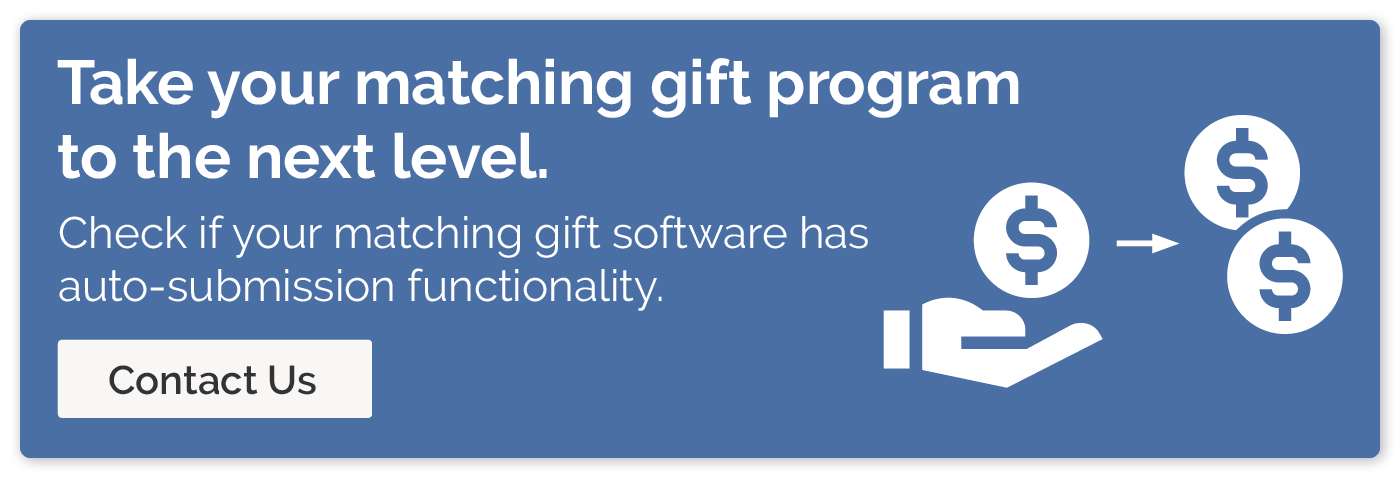CSR in Action: 7 Corporate Social Responsibility Examples
Nonprofits aren’t the only organizations that can make a positive social impact. In fact, trends in corporate social responsibility (CSR) show that in addition to large corporations, small and medium-sized businesses have also recently started launching their own philanthropy programs.
Businesses of all sizes and in all industries have the power to make a difference through CSR. They just need the right corporate giving tools, resources, a dedicated team, and a clear direction for their philanthropy.
To inspire your business’s future CSR program, we’ll take a look at the wide world of corporate philanthropy. Discover types of popular corporate giving initiatives and real-world CSR examples from the businesses that launch them. But first, let’s get started with a brief overview of just what CSR is.
What is Corporate Social Responsibility?
CSR refers to an organization’s societal values and awareness of its role in both its immediate community and the greater world.
While there is quite a bit of overlap between CSR and corporate philanthropy, the main difference is that corporate philanthropy is defined as specific actions a business takes, such as hosting a volunteer day, whereas CSR is more expansive.
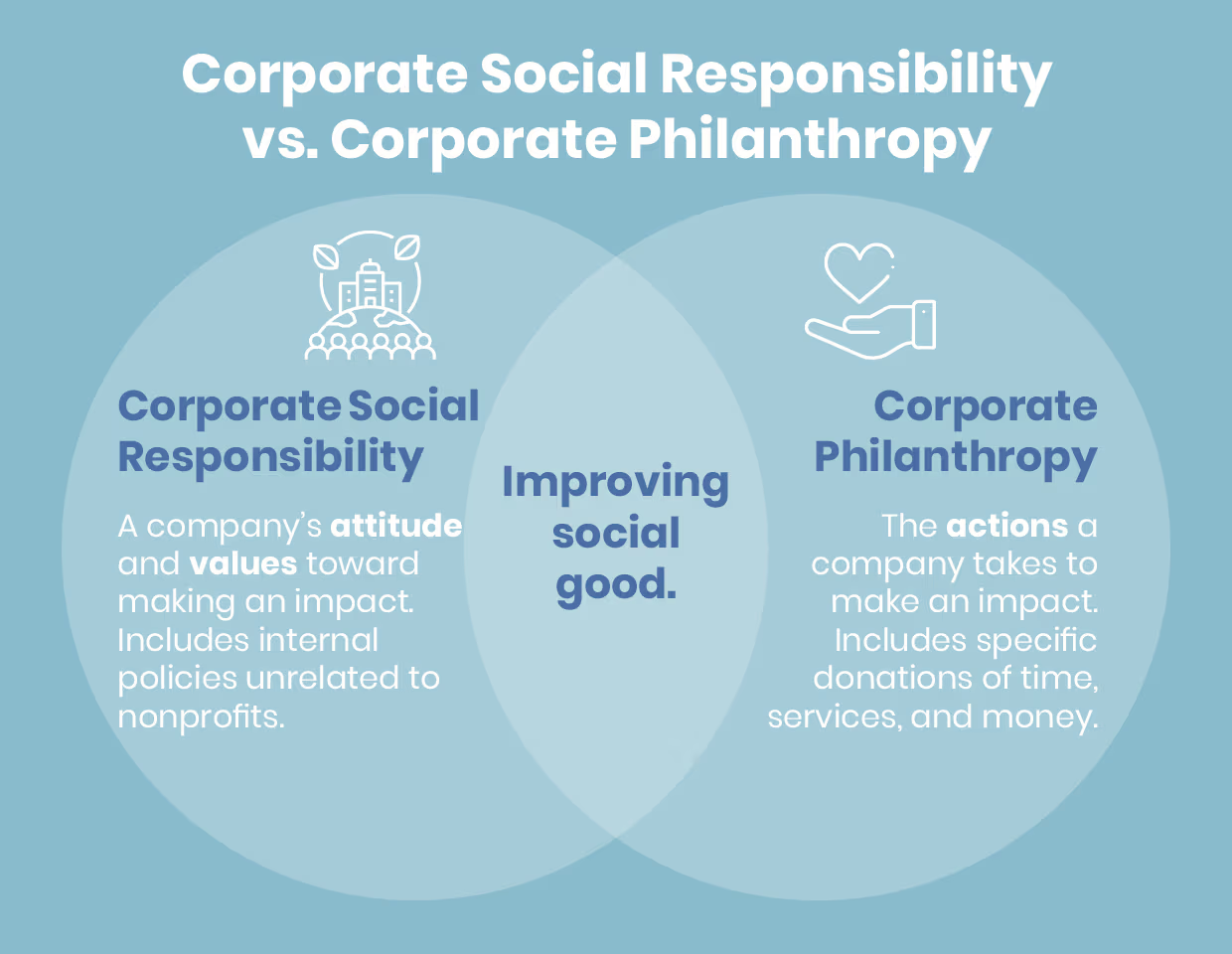
For example, CSR includes a company’s attitude to:
- Sustainability
- Workers’ rights
- Ethical business practices
- Environmental protection
- Social impact
Put another way, CSR is about more than just donating to nonprofits, though it can certainly include that as well. For instance, CSR could include adjusting business practices to meet environmental regulations and achieve a zero-carbon footprint, but those practices likely don’t involve making monetary or in-kind contributions to a charitable cause and would not be considered corporate philanthropy.
Why Does Corporate Social Responsibility Matter?
CSR programs provide nonprofits with the resources they need to complete their missions, ensure workers have supportive working conditions, and spread awareness of important causes.
Let’s look at some of the research on corporate giving:
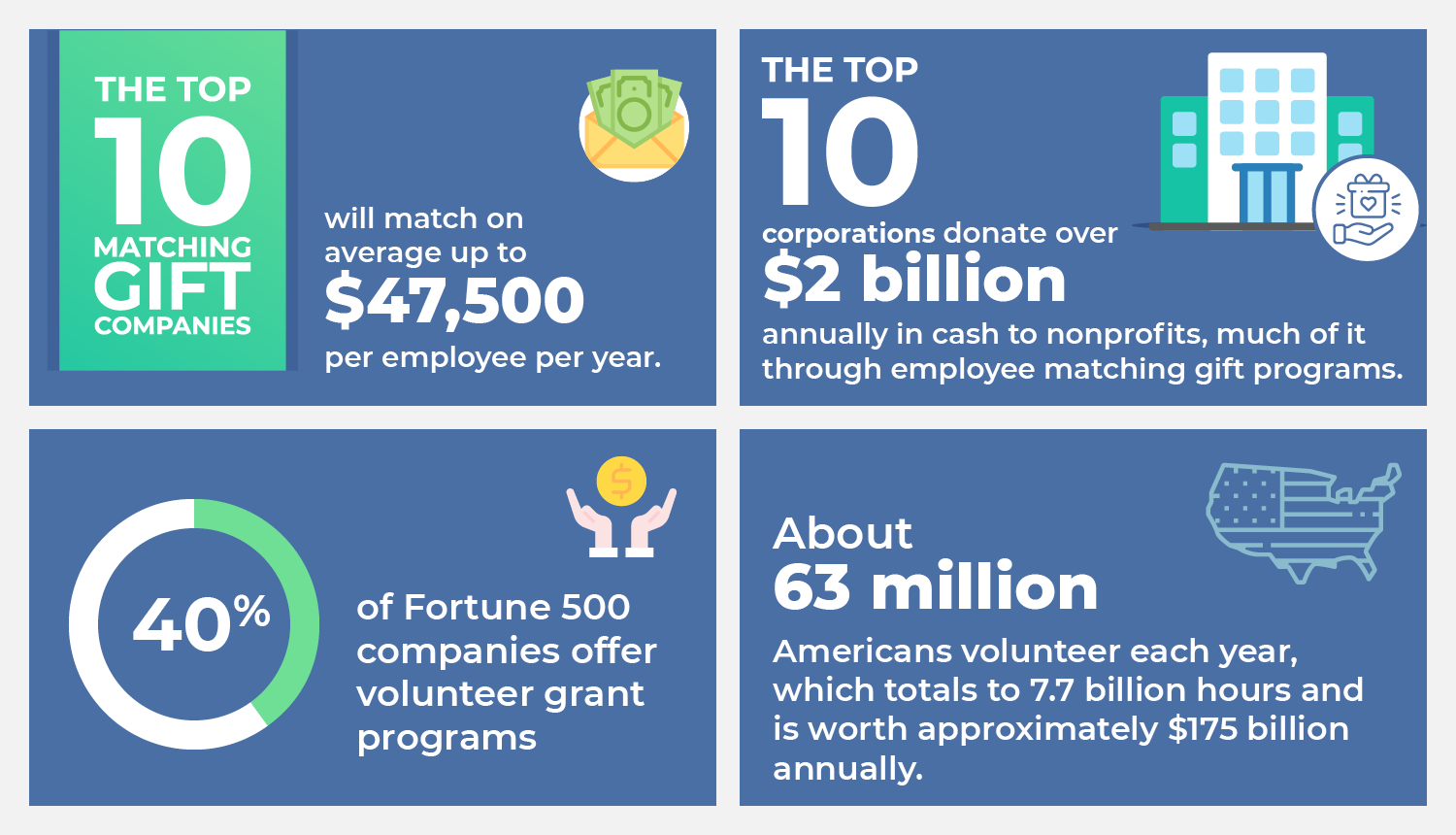
- On average, the top ten matching gift companies will match up to $47,500 per employee per year.
- The top ten corporations donate over $2 billion annually to nonprofits.
- 40% of Fortune 500 companies have volunteer grant programs.
- About 63 million Americans volunteer annually, which totals 7.7 billion hours and is worth approximately $175 billion annually.
Additionally, CSR also benefits the companies that implement these programs. Consumers want to buy from and employees want to work at businesses that are committed to social good, and CSR programs can provide a much-needed boost to a business’s reputation.
7 Corporate Social Responsibility Examples
There are thousands of CSR examples out there, and you can likely discover the results of some programs just by reading the daily news. But to spark your research and show the sheer variety of CSR programs out there, we’ll look at several types of popular CSR initiatives and a successful example of each program in action.
1. Matching Gifts
Companies looking to engage their employees and support a variety of causes should consider launching a matching gifts program. Matching gifts are a type of corporate giving where employers match the donations their employees make to charitable organizations. This allows businesses to show their commitment to the same causes their employees believe in, improving worker loyalty.
To start a matching gift program, companies should consider their requirements for the following match criteria:

- Match ratio. Most companies match at a 1:1 ratio, meaning that they will donate the same amount the employee did. Some are more generous, donating at 2:1 or even 3:1 rates. Other more conservative programs offer less at a 0.5:1 ratio. Higher match ratios can encourage greater employee participation, but be conscious of how much your business has allocated for matching gifts.
- Minimum and maximum matching gift amount. How much must employees donate for their gift to be match-eligible? What is the maximum amount an employee can have matched in a year? Lower minimums and higher maximums both increase participation, but keep an eye on your annual matching gift budget.
- Cause type. What types of organizations will you match gifts for? Some corporations restrict this to nonprofits with missions that align with the company’s stated philanthropic values, while others match for any verified 501(c)(3) their employees donate to. And others strike a balance by allowing most types of organizations with a few exceptions, such as excluding religious organizations.
- Employee status. Do only full-time employees qualify for matching gifts or are part-time and retired employees also eligible?
- Deadline. By what date must employees submit their matching gift applications? Some companies have a specific calendar date, like January 1st, while others require matching gift requests to be submitted a specific amount of time post-donation.
If you launch a new matching gift program, start researching CSR software. These platforms will allow you to better track funds allocated to matching gifts and create a more streamlined process for employees submitting matching gift requests.
Additionally, some CSR software now comes with matching gift auto-submission functionality through partnership with Double the Donation. Auto-submission enables employees to have their matching gift requests completed automatically for them, dramatically speeding up the process.
Deloitte
Deloitte is a leading provider of audit, risk advisory, financial consulting, and other related services. They also are committed to making a positive difference with their highly convenient matching gift program, making them one of the top matching gift companies.
Here are some of the highlights of Deloitte’s matching gift program:
- Maximum donation amount of $7,500 per year
- Special emphasis on matching gifts to educational institutions with an increased donation cap of $25,000 for gifts to strategic schools
- Auto-submission functionality enabled, allowing employees to submit their donation requests in seconds
If you’re looking for a company to model your matching gift program off of, Deloitte is just one of many inspiring matching gift companies.
2. Scholarships
With CSR programs, businesses can invest in their communities in several ways, such as supporting education. Awarding scholarships to high school students can be an especially valuable way to make a difference in local families’ lives, allowing their children to pursue higher education without financial worry.
For your scholarship program, consider the criteria students must meet to apply for your programs. At a minimum, this usually includes being related to someone who works at your company. Some companies have more stringent requirements, such as awarding scholarships to specific schools and fields of study.
Additionally, consider how you’ll weigh applications. Will you require an essay component or just look at students’ grades and extracurricular activities? Will you consider families’ financial status and other extenuating circumstances or try to evaluate applicants on a strictly merit-based system?
Remember, the more requirements you have, the fewer applications you’ll receive. Some businesses with scholarships have such specific qualifications that they don’t receive any applications! Strike a balance to support qualified students in your community without making them jump through too many hoops to receive aid.
Coca-Cola
Every year, the Coca-Cola Company supports the education of over 1,400 college students through the Coco-Cola Scholarship Foundation. The achievement-based scholarship is divided into three scholarship programs students can apply for:
- The Coca-Cola Scholars Program. High school seniors with at least a 3.0 unweighted GPA can apply to become one of the 150 annually selected Coca-Cola Scholars who receive a $20,000 scholarship.
- Coca-Cola Community College Academic Team. Current students at two-year community colleges can receive scholarships based on their merit. The company awards 50 $1,500 gold scholarships, 50 $1,250 silver scholarships, and 50 $1,000 bronze scholarships annually.
- Coca-Cola Leaders of Promise. 180 students at two-year community colleges can receive $1,000 scholarships.
While your company may not have the reach of Coca-Cola, you can still use its program as inspiration for structuring your own scholarship initiative.
3. Cause Awareness
Every business has a unique customer base and the ability to spread awareness of an important cause to that base. Educating their consumers about a specific nonprofit’s cause is a popular CSR approach for a few reasons. For instance, cause awareness:
- Publicizes the relationship between the business and the nonprofit. Many companies start CSR programs due to the corresponding reputation boost. With other types of CSR initiatives, you’ll need to launch a separate marketing effort to make customers aware of your philanthropy. With cause awareness campaigns, however, you perform social good by marketing your connection to a nonprofit, killing two birds with one stone.
- Provides the business access to the nonprofit’s audience. In a cause awareness campaign, your business gives the partner nonprofit access to your audience. In exchange, your business gains access to the nonprofit’s audience, allowing both organizations to reach more supporters than before.
- Uses pre-existing infrastructure. Your business can market a nonprofit’s cause the same way you would your products and services, meaning you won’t need to make any new investments, especially if the nonprofit you partner with agrees to help provide marketing materials.
For cause awareness CSR, work with a nonprofit—or multiple nonprofits—with missions relevant to your industry. For example, a pet store may help a local animal shelter fight animal abuse, or a software company might support STEM programs in underserved communities.
Google spreads awareness for thousands of nonprofits for free with the Google Ad Grant. Through the Google Ad Grant, nonprofits receive $10,000 in ad credits each month to use to promote their website through Google.
As part of the application process, Google ensures they are promoting reputable nonprofits to their users by:
- Verifying their 501(c)3 or non-USA equivalent nonprofit designation
- Checking their website to ensure it is secure
- Requiring nonprofits to post valuable content on their websites
For a more in-depth look at Google’s eligibility requirements, take a look at this quick video from Google Ad consultant, Getting Attention:
4. Sustainability

Environmental, social, and governance (ESG) is a rising topic in the corporate world with 83% of consumers believing that companies should actively implement ESG best practices. A top concern that’s at the heart of ESG is sustainability.
Sustainable businesses make better use of their resources, minimize their environmental footprint, and set themselves up to continue operating long-term. Of course, how to implement sustainable business practices is more obvious for some industries than others.
For instance, restaurants can start using paper straws and recyclable takeout containers, whereas a marketing company may need to get more creative with their sustainable practices. This might involve going completely digital, buying recycled office furniture, or sponsoring environmental-focused nonprofits.
NVIDIA
NVIDIA is a leader in the tech industry, specializing in computer chips and AI technology. Sustainability can be challenging for companies like NVIDIA due to the energy required for computer processing and the natural resources needed for creating hardware.
However, this hasn’t stopped NVIDIA from making several achievements related to environmental friendliness and sustainability, including:
- Creating GPUs that are 26x more energy efficient than standard CPUs
- Powering the most energy-efficient supercomputer as judged by the Green500 list
- Implementing a plan to match 100% of their electricity usage by purchasing or generating renewable energy
For a more in-depth look at their recent CSR program updates, check out NVIDIA’s 2023 Corporate Responsibility Report.
5. In-Kind Donations
Nonprofits appreciate monetary donations, but if your business has products or services that could help a nonprofit, you can cut out the need for a financial transaction and donate your products directly. Tangible goods and professional services are known as in-kind donations, and this approach is a convenient corporate giving program for many business sectors depending on what causes they support.
For example, a restaurant might provide free or discounted catering services to a charity benefit concert, or an accounting firm might have a few employees volunteer to perform free bookkeeping services.
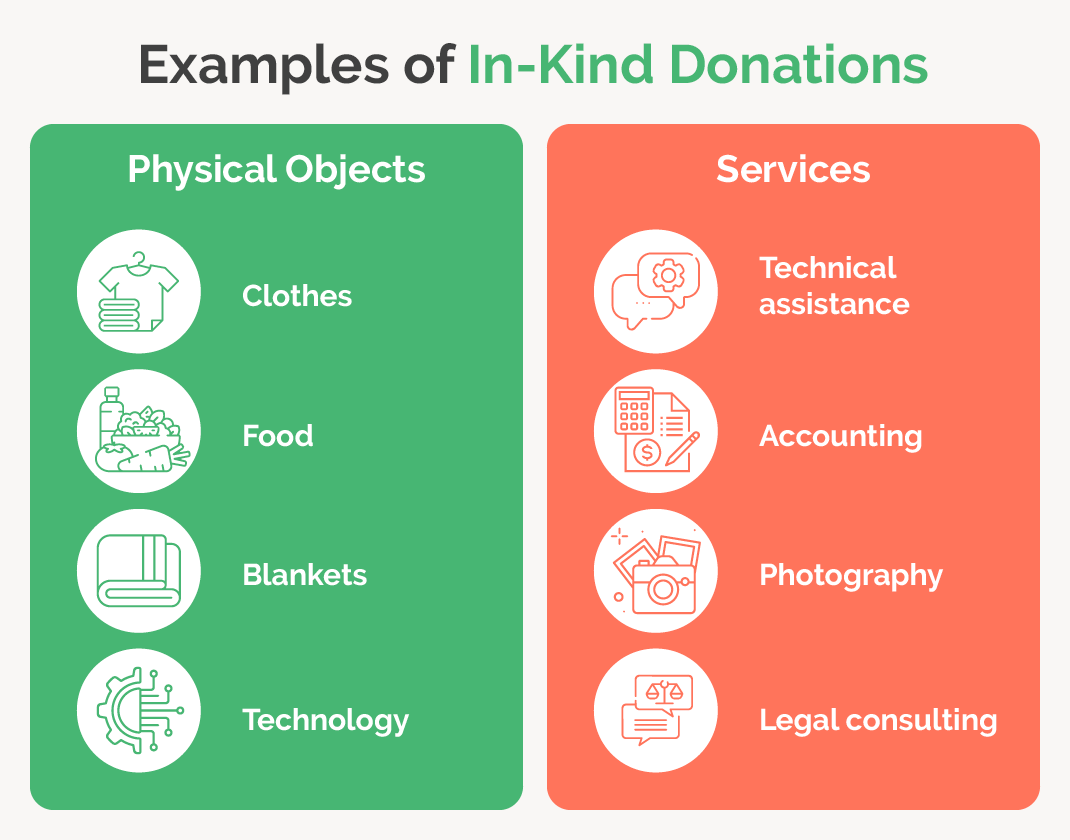
While non-monetary in nature, in-kind donations can also be claimed as tax write-offs. When making an in-kind donation, estimate the value of the products or professional services you’re donating.
Salesforce
Salesforce is one of the world’s leading CRM providers, serving various industries, including nonprofits. They offer multiple software solutions for nonprofits, such as Salesforce NPSP and Salesforce Nonprofit Cloud.
However, Salesforce also recognizes that many nonprofits have tight budgets. To help these organizations, Salesforce offers ten free software licenses to verified nonprofit customers. Nonprofits can access this free software through Salesforce’s the Power of Us Program. All nonprofits need to do is:
- Check if they meet the program’s qualifications, which most U.S.-based nonprofits will achieve with the exception of healthcare organizations, which are not eligible.
- Login to the Power of Us Portal to submit their application. For this step, nonprofits will need to have their Tax ID number and their 501(c)(3) or 501(c)(4) letter.
- Once their application is reviewed and accepted, which takes approximately 2-3 weeks, nonprofits will be able to select their free Salesforce products.
For your business, consider what products or services you can make free or heavily discounted for nonprofits, which nonprofits you’ll provide in-kind donations to, and how you’ll verify that nonprofits meet your eligibility requirements.
6. Workplace Training for Underprivileged Groups
Does your business have a strong training program that you’re proud of? Are you in a high-growth sector with potential new hiring opportunities? And do you have the resources to provide free training services to individuals who would otherwise be unable to afford them?
If you answered “yes” to the above questions, then your company should consider implementing a CSR initiative focused on workplace and skill training. These types of programs are most impactful when they empower underserved groups with limited economic advancement options.
For example, you might partner with a local school to provide extracurricular skills training classes or work with a nonprofit to lend your resources and expertise to their adult education programs.
Slack
Slack is well known for its workplace communication software, and they’re committed to creating a more equitable workforce with the Next Chapter Project. The Next Chapter Project is a nonprofit dedicated to helping formerly incarcerated individuals get the training and support they need to become software engineers.
Along with providing training, the Next Chapter Project leverages Slack’s partnership network to help its program participants get work placements at several reputable technology companies, including PayPal, Asana, Checkr, DropBox, and more. Slack, of course, also hires many of the Next Chapter Project’s alumni.
7. Advocacy
Often, the greatest impact happens due to legislative action and societal change, which both require advocacy. Advocacy campaigns have the potential to unite communities, spread awareness of key issues, and push for positive change. However, these campaigns also need many resources to get their message out there, which is where corporate partners come in.
Businesses can sponsor local advocacy groups or start their own campaigns, usually by creating a foundation. These campaigns should focus on legislative topics, such as environmental issues, workers’ rights, and economic justice, rather than being for or against a specific party. In other words, your advocacy foundation or party advocacy group argues for policies rather than political candidates.
To get started with an advocacy campaign, look at your local government and the issues facing your community rather than jumping to the state or federal level. More often than not, societal change begins with grassroots movements, and efforts aimed at your local community will likely be easier to fund and monitor, especially if you’re just getting started with advocacy.
Ben & Jerry’s
Founded in 1985, The Ben & Jerry’s Foundation reflects the corporation’s commitment to workers’ rights and social justice. The foundation provides grants to 501(c)(3) grassroots advocacy groups across the United States with special attention to groups in their home state of Vermont.
The goal of the Ben & Jerry’s Foundation is to empower local groups that consist of the people closest to the issues and thus who are the most knowledgeable and committed to solving them. To make sure these groups are the ones their grants go to, they require that all organizations have an operating budget of under $350,000 and that submitted grant applications embody the following strategies:
- Community and ally outreach
- Leadership development of constituents
- Constituent empowerment and decision-making
- Popular education
- Root cause analysis
- Power analysis
- Campaign development
- Constituent and ally mobilization
- Coalition building
- Non-violent direct action
For your own advocacy efforts, consider your company’s values and how you can assess the groups you plan to work with. Consider each advocacy group’s familiarity with target issues, their plan of action, the potential impact of their plan, and whether your company’s assistance can make a notable difference in their success.
Corporate Social Responsibility Examples Summarized
Companies all over the world leverage their resources and influence to make their communities a better place, and yours can too. Even small and medium-sized businesses can implement CSR initiatives that improve working conditions, promote environmentally friendly practices, and foster goodwill with consumers and employees alike.
Of course, CSR is a broad topic, and examples of successful CSR programs are just the beginning. To learn more about CSR and the types of programs your company could launch, consider these resources:
- How to Develop a Corporate Charitable Giving Policy: A Guide. How will your company decide what causes to support? Explore the nuances of creating a corporate giving policy.
- Corporate Giving Software: How to Choose the Best Solution. Interested in corporate philanthropy in addition to CSR? Discover the technology you need to get started with corporate giving.
- Corporate Social Responsibility: How to Make Your Mark. Need a refresher on the basics of CSR before launching your program? Make sure your understanding is rock solid with this essential guide.

